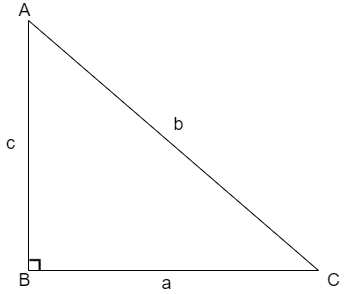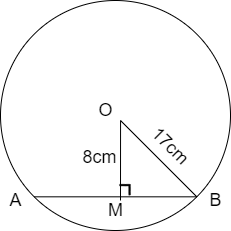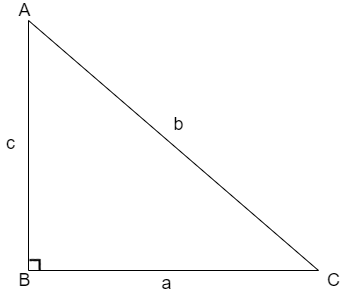
AB is the chord of the circle of centre O and the radius is 17 cm. If \[OM\bot AB\] and \[OM=8cm\] then the length of the chord AB is
(a) 12 cm
(b) 30 cm
(c) 15 cm
(d) 24 cm
Answer
555k+ views
Hint: We solve this problem by using the condition of chords and the Pythagoras theorem.
We use the condition that perpendicular from the center to any chord of the circle divides the chord into two equal parts.
Then we use the Pythagoras theorem to find the value of AB.
The Pythagoras Theorem states that the square of the hypotenuse is equal to the sum of squares of the other two sides that is for the triangle shown below

Let us take the rough figure that represents the given information as

We are given that the radius of the circle is 17 cm.
Here, we can see that from the figure the radius can be taken as
\[\Rightarrow OB=17cm\]
We are also given that \[OM\bot AB\] and \[OM=8cm\]
Now, let us consider the triangle \[\Delta OMB\]
We know that the Pythagoras Theorem states that the square of the hypotenuse is equal to the sum of squares of other two sides that is for the triangle shown below

The Pythagoras theorem is given as\[{{b}^{2}}={{a}^{2}}+{{c}^{2}}\].
Now, applying the Pythagoras theorem to triangle \[\Delta OMB\] then we get
\[\Rightarrow O{{B}^{2}}=O{{M}^{2}}+M{{B}^{2}}\]
By substituting the required values in above equation we get
\[\begin{align}
& \Rightarrow {{17}^{2}}={{8}^{2}}+M{{B}^{2}} \\
& \Rightarrow M{{B}^{2}}=289-64 \\
& \Rightarrow MB=\sqrt{225} \\
& \Rightarrow MB=15 \\
\end{align}\]
We know that the condition that perpendicular from the centre to any chord of the circle divides the chord into two equal parts.
By using the above condition to the figure then we get
\[\begin{align}
& \Rightarrow AB=2MB \\
& \Rightarrow AB=2\times 15 \\
& \Rightarrow AB=30 \\
\end{align}\]
Therefore we can conclude that the length of chord AB is 30 cm.
So, option (b) is the correct answer.
Note:
We can solve this problem in another method also.
We have the direct formula for the length of perpendicular from centre of circle to chord length of \['l'\] and radius of circle \['r'\] is given as
\[d=\dfrac{1}{2}\sqrt{4{{r}^{2}}-{{l}^{2}}}\]
By using the above formula to the given figure we get
\[\begin{align}
& \Rightarrow OM=\dfrac{1}{2}\sqrt{4O{{B}^{2}}-A{{B}^{2}}} \\
& \Rightarrow 4O{{M}^{2}}=4O{{B}^{2}}-A{{B}^{2}} \\
& \Rightarrow A{{B}^{2}}=4\left( O{{B}^{2}}-O{{M}^{2}} \right) \\
\end{align}\]
By substituting the required values in above equation we get
\[\begin{align}
& \Rightarrow A{{B}^{2}}=4\left( {{17}^{2}}-{{8}^{2}} \right) \\
& \Rightarrow AB=\sqrt{4\times \left( 289-64 \right)} \\
& \Rightarrow AB=\sqrt{900} \\
& \Rightarrow AB=30 \\
\end{align}\]
Therefore we can conclude that the length of chord AB is 30 cm.
So, option (b) is the correct answer.
We use the condition that perpendicular from the center to any chord of the circle divides the chord into two equal parts.
Then we use the Pythagoras theorem to find the value of AB.
The Pythagoras Theorem states that the square of the hypotenuse is equal to the sum of squares of the other two sides that is for the triangle shown below

Let us take the rough figure that represents the given information as

We are given that the radius of the circle is 17 cm.
Here, we can see that from the figure the radius can be taken as
\[\Rightarrow OB=17cm\]
We are also given that \[OM\bot AB\] and \[OM=8cm\]
Now, let us consider the triangle \[\Delta OMB\]
We know that the Pythagoras Theorem states that the square of the hypotenuse is equal to the sum of squares of other two sides that is for the triangle shown below

The Pythagoras theorem is given as\[{{b}^{2}}={{a}^{2}}+{{c}^{2}}\].
Now, applying the Pythagoras theorem to triangle \[\Delta OMB\] then we get
\[\Rightarrow O{{B}^{2}}=O{{M}^{2}}+M{{B}^{2}}\]
By substituting the required values in above equation we get
\[\begin{align}
& \Rightarrow {{17}^{2}}={{8}^{2}}+M{{B}^{2}} \\
& \Rightarrow M{{B}^{2}}=289-64 \\
& \Rightarrow MB=\sqrt{225} \\
& \Rightarrow MB=15 \\
\end{align}\]
We know that the condition that perpendicular from the centre to any chord of the circle divides the chord into two equal parts.
By using the above condition to the figure then we get
\[\begin{align}
& \Rightarrow AB=2MB \\
& \Rightarrow AB=2\times 15 \\
& \Rightarrow AB=30 \\
\end{align}\]
Therefore we can conclude that the length of chord AB is 30 cm.
So, option (b) is the correct answer.
Note:
We can solve this problem in another method also.
We have the direct formula for the length of perpendicular from centre of circle to chord length of \['l'\] and radius of circle \['r'\] is given as
\[d=\dfrac{1}{2}\sqrt{4{{r}^{2}}-{{l}^{2}}}\]
By using the above formula to the given figure we get
\[\begin{align}
& \Rightarrow OM=\dfrac{1}{2}\sqrt{4O{{B}^{2}}-A{{B}^{2}}} \\
& \Rightarrow 4O{{M}^{2}}=4O{{B}^{2}}-A{{B}^{2}} \\
& \Rightarrow A{{B}^{2}}=4\left( O{{B}^{2}}-O{{M}^{2}} \right) \\
\end{align}\]
By substituting the required values in above equation we get
\[\begin{align}
& \Rightarrow A{{B}^{2}}=4\left( {{17}^{2}}-{{8}^{2}} \right) \\
& \Rightarrow AB=\sqrt{4\times \left( 289-64 \right)} \\
& \Rightarrow AB=\sqrt{900} \\
& \Rightarrow AB=30 \\
\end{align}\]
Therefore we can conclude that the length of chord AB is 30 cm.
So, option (b) is the correct answer.
Recently Updated Pages
Two men on either side of the cliff 90m height observe class 10 maths CBSE

What happens to glucose which enters nephron along class 10 biology CBSE

Cutting of the Chinese melon means A The business and class 10 social science CBSE

Write a dialogue with at least ten utterances between class 10 english CBSE

Show an aquatic food chain using the following organisms class 10 biology CBSE

A circle is inscribed in an equilateral triangle and class 10 maths CBSE

Trending doubts
Which of the following does not have a fundamental class 10 physics CBSE

Differentiate between Food chain and Food web class 10 biology CBSE

State BPT theorem and prove it class 10 maths CBSE

A Gulab jamun contains sugar syrup up to about 30 of class 10 maths CBSE

What is UltraEdge (Snickometer) used for in cricket?

Write the difference between soap and detergent class 10 chemistry CBSE




